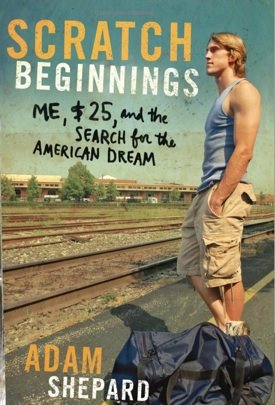Journal 2. Scratch Beginnings.
March 3, 2009.
The author of the book we are studying is Adam G. Shepard. Scratch beginnings is his only work so far. On a basketball scholarship, he went to Merrimack College, in North Andover, Massachusetts. During his time there, he began to take interest in social issues, which nurtured his desire to explore the American Dream, the premise of his book. He graduated in 2006 with a degree in Business Management and Spanish. Not having found a job, he thought that he was as close to down-and-out which set up the perfect time to try his experiment of whether or not the American Dream still existed (About the Author).
March 3, 2009.
The author of the book we are studying is Adam G. Shepard. Scratch beginnings is his only work so far. On a basketball scholarship, he went to Merrimack College, in North Andover, Massachusetts. During his time there, he began to take interest in social issues, which nurtured his desire to explore the American Dream, the premise of his book. He graduated in 2006 with a degree in Business Management and Spanish. Not having found a job, he thought that he was as close to down-and-out which set up the perfect time to try his experiment of whether or not the American Dream still existed (About the Author).
Adam Shepard’s intention was to see if the American Dream was still alive. In the book he states, “Socioeconomically speaking, my story is a rebuttal to Barbara Ehrenreich’s Nickel and Dimed and Bait and Switch…” (Shepard 3). These books deal with the idea that the American Dream is dead. He designed an experiment were he started out with a tarp, gym bag, sleeping bag, $25 and the clothes on his back. He explained that it would be success if he was able to have a working car, a furnished apartment and $2500 in cash. He would have “365 days to become free of the realities of homelessness and become a “regular” member of society.” Through his experience he would record his observations of the struggles that he encountered as he tried to improve his quality of life (Shepard 2).
He started with basically nothing with the hope of achieving a regular social status. His information is gathered through first-hand experiences. He is living in a homeless shelter for the time being. He is surrounded by actual homeless people who are trying to make their way in America. By doing this he is able to observe their attitudes and actions. This is an effective way of collecting information about the culture. He is accepted as one of them, because he has made up a story of his own. He has conversations with a few people at the shelter and learns a lot about their lives and where things went wrong. He participates in the same activities as his fellow shelter-mates. So far he has had to get around without a personal vehicle. He utilizes the public transportation system and rides from the labor agency. He works at temporary jobs and is trying to get a full-time job.
The way he gathers his information is very effective. He is not just an outside observer. He completely absorbs the role of a homeless person and is able to really experience the same treatments that they have. No one is behind the scenes doing him any favors; he has the same opportunities as anyone else in a similar situation.
The critics were mainly positive, but another one, kept our attention. Indeed, that person explained that it is probably easier for a White male in his early twenties to get out of a homeless condition than someone who already has a family or is from is from a different race. He also came from a Middle class family and had a college degree, with no health problems, or substance-abuse problems. This is not typical of most homeless people (Young).
Works Cited:
“About the Author.” Scratch Beginnings: me, $25, and the Search for the American Dream. <http://www.scratchbeginnings.com/about-the-author>.
Shepard, Adam. Scratch Beginnings: Me, $25, and the Search for the American Dream.
Chapel Hill, NC: SB Press, 2008.
Young, Emily. “How accurately does Adam Shepard's experience reflect the American reality?” The Eagle-Tribune. 20 January 2008. http://www.eagletribune.com/punews/local_story_020094014

Thanks! :)
ReplyDelete